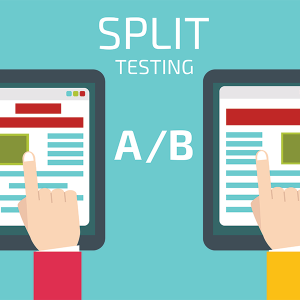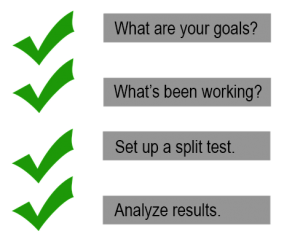4 Email Marketing Testing Tips to Maximize Results
 Whether you sell business-to-business (b2b) or business-to-consumer (b2c), the reason you are using email marketing is to stay top of mind and generate new prospects and sales, correct?
Whether you sell business-to-business (b2b) or business-to-consumer (b2c), the reason you are using email marketing is to stay top of mind and generate new prospects and sales, correct?
If yes, then it’s time to raise the bar and get better results than you ever did last year. Here’s a 4-step “cheat sheet” with the action items you need to achieve your goals. And here’s one key takeaway: Always review the results of your email campaigns and then test in a disciplined, consistent manner. If you do that, your results will improve.
Step #1: Decide on your goals!
Don’t rush into this. Take a step back and ask your team what the goals are for your email marketing campaigns.
Here are a few examples of possible campaign goals:
- Opens. You want more people to know who you are and to open your messages.
- Clickers. You want more people to click through to your Web site.
- Engage. You want more people to read your social media or blog.
- Leads. You want more prospects to sign up on your landing page.
- Sales. You want more conversions on your e-commerce site.
- Re-engage. You want inactive people to return to your business.
Which goal is most important to you?
Step #2: Determine what’s working and what’s not!
Take a look at your email marketing’s performance over time and critique it with questions like these:
- Are my readers bored with my subject lines? Are they stale? (Fewer opens?)
- Are my “calls-to-action” (CTA) working? (Fewer click-throughs?)
- When was the last time I changed the design of my email?
- Are the design, wording, and location as good as they can be?
- Is my content understandable? Or are my readers confused and, therefore, not responding?
- Am I driving traffic to my web site but not converting that traffic into sales?
- Am I sending out my emails on the day and time that’s most effective?
Step #3: Time to test!
The beauty of email marketing is that you can check the results within  hours after sending and observe the results. It’s not like you’re sending ou
hours after sending and observe the results. It’s not like you’re sending ou
t a magazine or a print newsletter and have to wait days or weeks for reply cards to come back.
Testing requires setting up an A-B test, which is quick and easy to do! But the key point is that you need to change only one variable at a time so that you can correctly evaluate the effect of the change. If you change two or more variables, how will you know which variable caused the change?
Depending on your goal, here are some examples of good ways to test:
To optimize your open rate, test each one of these, one at a time —
- “From” name. Test different “from” addresses (i.e. from the salesperson or from, say, info@yourcompanyname).
- Subject line. Test using short or long subject lines. Should it be a tease or a direct offer?
- Personalization. Test for personalization in subject line. Should the recipient’s name be included or not?
- Best day or time to send – Typically B2B is better during the work week and work hours and B2C is better evenings and weekends. But don’t listen to me, test on your own.
To optimize your click-through rate, test each one of these one at a time —
- Creative/layout. Test different designs.
- Subject lines. Should you mention the offer or not?
- Offer. Test different locations, wordings, and designs of your CTA.
- Copy. Test which articles resonate the most with your readers. Test the same topics in various locations.
- Pre-header. Test the effectiveness of having your offer in the pre-header above the masthead.
To optimize your conversion rate, test each one of these one at a time –—
- Landing pages. Test for different designs, CTA locations, form placements, etc.
- Subject lines. Test using teasers or direct offers.
- Calls-to-action. Test different wordings and locations. Should it appear once or multiple times in the email?
- Creative/layout. Does a mobile-friendly version have an impact on results?
- Offer. Which offers convert the most best?
Step #4: Analyze the results + implement changes!

Many people ask what’s the best day to send, what’s the best time to send, what’s the best subject line, should I send on a workday or a weekend, and so on. The answer is that there is no inherent right or wrong approach. What you need to do is test and compare your own results. Read Email Marketing Metrics Roundup for more on comparing results.
Your goal isn’t to achieve a specific number; it’s to improve your numbers. You want to test against your own benchmark, not an industry benchmark. What works best for your demographics may not work for someone else’s demographics. Besides, it doesn’t matter how the other guys are doing. If you improve from your own results, you’re doing fine. Just keep going!
[Tweet “Test for personalization in the subject line. Should the recipient’s name be included or not? #EmailMarketing”]Measure and analyze the results to gain insight and then change your tactics accordingly. Run a test 2-3 times before you jump to the conclusion that something does or doesn’t work. Make sure you document your tests in an organized manner as even small percentage changes can mean large gains in response rates.
When you implement the changes make them one at a time. Take your time and use your common sense. Look beyond the numbers to find meaning if the numbers don’t make sense.
And when all is said and done, don’t get overwhelmed with all this homework. Keep it simple. Pick a few tests that are relevant to your business. Not only will you learn more about your readers, but you are guaranteed to improve your results and your ROI.













